Since our professional truck driving career began, the Freightliner Cascadia is the classiest truck either of us has ever driven or lived in.
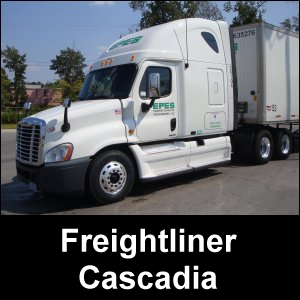 With that being said, the following is a list of pros and cons that we compiled when Mike drove the truck during his most recent regional truck driving job, when Vicki was riding with him full-time as his home support team.
With that being said, the following is a list of pros and cons that we compiled when Mike drove the truck during his most recent regional truck driving job, when Vicki was riding with him full-time as his home support team.
Sometimes it is the little features of a truck that can help make it a little bit more like home.
Conveniences can help drivers save money.
We are therefore listing the pros, cons and other considerations of a Freightliner Cascadia.
Pros of a Freightliner Cascadia
- Deep storage under passenger side cabinet (where we stored our water jugs; we also installed a couple of battery-operated puck lights so that we could see way in the back without having to use a flashlight)
- No narrow crevice between cabinet and bunk in the sleeper (meaning no “loss” of little things in a hard-to-reach area)
- Cabinets with doors instead of netting
- In-truck satellite communication terminal (“Jill”) has setting so that the driver can turn off the loud “beep” while sleeping
- Much better insulation to cut down on outside noise
- Swivel seats up front
- Extendable visors to block out sun
- Engine brake (“Jake brake”) with 3 different settings
- On/Off switch for battery disconnect to preserve power when truck is not in use
- Vent and heater unit under bunk is designed to save money
- Movement of some settings from the dash to the steering wheel, at the driver’s fingertips
- Steering wheel has intermittent windshield wiper setting
- Tractor has a better suspension and gives a better ride
- Air suspension/spring on hood prevents hood from slamming down
- Batteries moved to a better, more accessible location, especially for inverter installation
- Vinyl mat on the floor throughout the cab instead of carpet
- Pull-out drawer for paperwork under the top cabinet behind the driver’s seat
- Bigger front windshield
- Greatly improved air flow vents in the sleeper
- Improved aerodynamics (air fairings and rounded edge mirrors)
- Enough room between the dash and the passenger seat to hold our portable ice maker
- Side truck mirrors fold in
- The truck Mike drove had a CB antenna already installed.
Photo Gallery of the Pros
 The vent and heater control panel for the unit under the bunk in the Cascadia from Freightliner.
The vent and heater control panel for the unit under the bunk in the Cascadia from Freightliner.
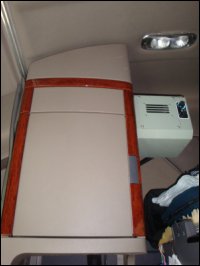 The top part of the storage cabinet behind the passenger seat.
The top part of the storage cabinet behind the passenger seat.
Note: at the right of the cabinet, you will see a climate control unit installed. This did not come with the truck.
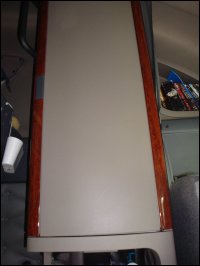 The storage cabinet with a door behind the driver’s seat.
The storage cabinet with a door behind the driver’s seat.
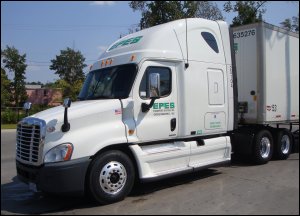 Although the Cascadia’s side mirrors are set lower, they are designed to fold in.
Although the Cascadia’s side mirrors are set lower, they are designed to fold in.
Cons of a Freightliner Cascadia
- Small window on door does not open
- Side windows will not roll down when the engine is off
- Window operation buttons are set in reverse of what is intuitive to control up and down motion
- Deep well on the dash
- Dome light switch must be turned off where it is turned on
- Overhead storage compartment area greatly restricted and reduced in size
- Overhead storage compartment door opens awkwardly for tall drivers
- Area around fuel tank opening does not allow rubber tie-downs to be stretched over fuel pump handles as easily when fueling
- Idle setting must be manipulated to keep idling, otherwise the truck shuts off part of its function after a short period of time
- Mirrors are smaller
- Mirrors are set lower, making it harder to see things set higher
- Less storage area on the dash for small things
- Light under bunk set on the back wall
- Angle of dash on top with no mounting bracket for CB radio
- Air vents on dash move only half-way
- Loss of cabinet space due to ventilation piping to the sleeper (a better design should have been used)
- Inability to remove built-in closet rod for those who do not want to use hangers to hang up clothes.
- Constant glow of amber or blue lights in the bunk when certain air or heat settings were on
- Poor design of the air outlet from the under-bunk heater unit
- The mattress that came with this truck does not reflect the truck’s high quality. A better grade of sleeper mattress really needs to come standard with all Freightliner trucks.
Photo Gallery of the Cons
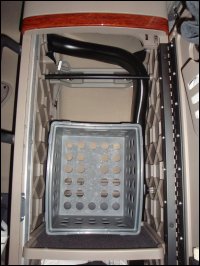 The ventilation pipe in the back and the closet rod spanning from side to side in the storage cabinet behind the driver’s seat.
The ventilation pipe in the back and the closet rod spanning from side to side in the storage cabinet behind the driver’s seat.
We put a gray rectangular box in the closet so that clothing could be stacked.
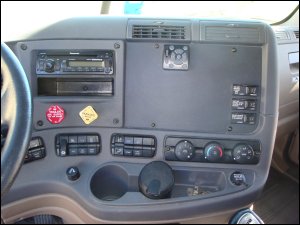 The dash in the Cascadia was re-designed with very little storage space and a deep well down toward the windshield.
The dash in the Cascadia was re-designed with very little storage space and a deep well down toward the windshield.
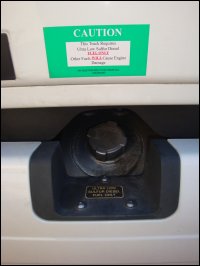 The fuel tank access area has been re-designed so as to prevent easy hooking of a rubber tie-down over an inserted fuel nozzle.
The fuel tank access area has been re-designed so as to prevent easy hooking of a rubber tie-down over an inserted fuel nozzle.
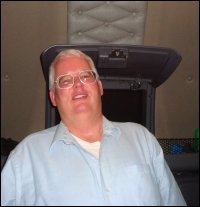 Tall drivers had better beware the door of the overhead storage compartment in the Cascadia. Mike always had to be careful when he stood up when the door was open.
Tall drivers had better beware the door of the overhead storage compartment in the Cascadia. Mike always had to be careful when he stood up when the door was open.
Other Considerations
- Overhead storage: The reduction of the overhead storage area in the Freightliner Cascadia — as compared to the Freightliner Columbia — is one of the truck’s weakest points. Perhaps the reduction of storage area was traded for better insulation.To make up for this room, a built-in desk (pull-out drawer) was installed under the top cabinet behind the driver’s seat.
- Inverter installation: The relocation of the batteries in the Freightliner Cascadia required a relocation of our 1500 watt inverter (because of the length of the wiring kit cables) to the small cabinet under the pull-out drawer.Although one of the mechanics at Mike’s trucking company “anchored” the inverter to the bottom of the cabinet, that “bottom” was basically a piece of cardboard or particle board from which the screws could be pulled out without much difficulty.In order to use the inverter’s power easily, we ran a 6-foot electrical cord from a surge protector power strip up through the Freightliner Cascadia’s cabinet from the bottom so that it would be available to power whatever we wanted to use (mostly cooking appliances).This worked out better than in the Columbia, where we had to run the surge protector power strip’s cord out from under the lower bunk (thus “pinching” the cord every time the bunk was lowered or in the “down” position).
- Constant glow: The amber light was on the control panel, right near where the lower bunk’s occupant laid his/her head.The blue light only glowed when the bunk heater unit’s fan was on. If the heater was on, the other light was on.Vicki learned to cover over the amber and blue lights in the lower bunk of the Freightliner Cascadia, so that she could sleep better.
- Battery charge protection: At the time that Mike drove for the trucking company that issued him the Freightliner Cascadia, they did him a very big disservice by not installing a diesel-powered APU on the truck. Instead, they installed a battery-operated climate control system only.That unit had its own problems, but one thing became apparent regarding its use on the truck: when the charge on the truck’s batteries got down to a certain level, the truck turned off certain supplies of power (such as to the climate control system), so as to reserve enough “juice” for cranking power.We have a feeling that that is what happened with a certain built-in heater unit that we had, too.
Photo Gallery of Other Considerations
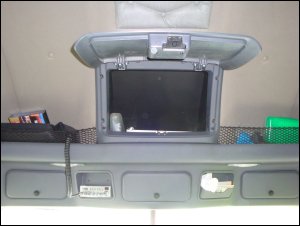 The overhead storage area was greatly reduced in this model truck.
The overhead storage area was greatly reduced in this model truck.
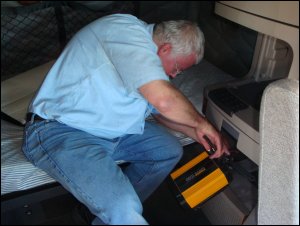 With the movement of the battery bank, the inverter had to be moved from under the bunk to the storage area behind the driver’s seat.
With the movement of the battery bank, the inverter had to be moved from under the bunk to the storage area behind the driver’s seat.
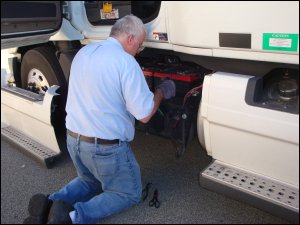 Freightliner trucks moved the battery bank from beneath the catwalk behind the cab to behind and below the driver’s seat.
Freightliner trucks moved the battery bank from beneath the catwalk behind the cab to behind and below the driver’s seat.
The batteries can be accessed by removing a side fairing. This may help reduce battery theft.
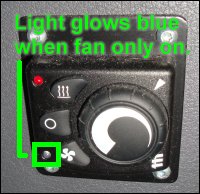 The bunk heater control panel glows a bright blue when the vent is on.
The bunk heater control panel glows a bright blue when the vent is on.
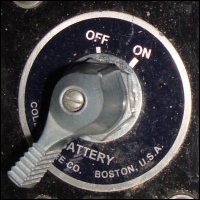 Freightliner trucks were redesigned so that the batteries can be disconnected at the turn of this switch.
Freightliner trucks were redesigned so that the batteries can be disconnected at the turn of this switch.
This is a positive change.
Summary
There is a great deal of storage room (except for the area over the driver’s and passenger’s heads) in the Freightliner Cascadia.
A driver who is concerned about saving money on the road can easily outfit his/her truck with plenty of food, water, meal preparation items, clothing and other things from a customized packing list.
There is even room to place a well-stocked emergency kit.
We saved a great deal of money by cooking our own meals in Mike’s truck.
For climate control and electrification, we had to idle the truck more than we wanted.
If Mike’s company had had an APU installed, this would have lowered the fuel consumption and toll on the engine considerably.
It was in this truck that we began hauling two ice chests for perishable foods, which we kept full of ice that we made with our portable ice maker.
All we had to do was supply the power from the inverter and make sure it had sufficient drinking water.
We enjoyed organizing the space in the truck to make it more home-like.
It was hard to feel homeless when we lived in this truck.
Were we in the market to become long-haul owner-operators, we would seriously entertain the idea of buying a Freightliner Cascadia to drive.
Although it has its faults, the Freightliner Cascadia is still the best truck we’ve ever driven or lived in.
Return from Review of Freightliner Cascadia by a Pro Truck Driver and Wife to our Product Reviews page or our Truck Drivers Money Saving Tips home page.









